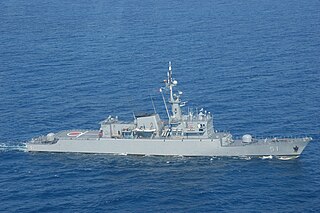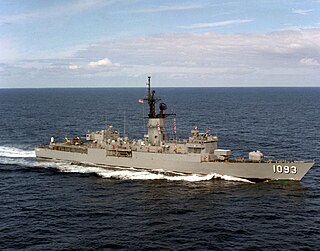
The Santa María class of guided missile frigates is the Spanish Navy's designation for six warships based on the United States Oliver Hazard Perry-class frigates. Spanish ships have a slightly bigger beam and were built with a greater weight reserve for future improvements. Other changes from the basic model include Meroka replacing Phalanx and a RAN-12L air search radar to provide low horizon coverage against sea skimmers cueing the Meroka CIWS mount. The Nettunel EW suite replaced the SLQ-32 system fitted aboard US ships. The first ship Santa Maria entered service in 1986.

USS Knox (DE/FF-1052) was the lead ship of her class of destroyer escorts in the United States Navy. Knox was named for Commodore Dudley Wright Knox, and was the second US Navy ship named Knox. In 1975, she was redesignated a frigate. She served from 1969 to 1992, and was sunk as a target in 2007.

ROCS Yueh Fei, is a Cheng Kung-class guided-missile frigate of the Republic of China Navy (ROCN). She is the fourth ship of the class. Named for the famous Chinese commander Yue Fei, the ship was constructed by the China Shipbuilding Corporation at their yard in Kaoshuing, Taiwan. The Cheng Kung-class frigates are based on the American Oliver Hazard Perry class and share many of the same characteristics, the main difference being armed with Taiwanese Hsiung Feng II and Hsiung Feng III surface-to-surface missiles and different sensors. Yueh Fei was laid down on 5 September 1992, launched on 26 August 1994 and commissioned into the ROCN on 7 February 1996.

Santa María (F81) is the lead ship of six Spanish-built Santa Maria-class frigates of the Spanish Navy, based on the American Oliver Hazard Perry class design. The vessel was constructed in 1982 and was launched on 11 November 1984. Santa María was commissioned on 12 October 1986. The frigate has served in NATO maritime operations.

Reina Sofía (F84) is the fourth of six Spanish-built Santa María-class frigates of the Spanish Navy. The Santa María class is based on the American Oliver Hazard Perry-class design, providing an anti-air warfare platform with anti-submarine and anti-surface warfare capabilities at a reduced cost. Reina Sofía was constructed by Bazan and was laid down on 12 October 1987 and launched on 19 July 1989. The ship was commissioned in 1990 and has seen service in the Mediterranean Sea and off Somalia.

Canarias (F86), is the last of the six Spanish-built Santa Maria-class frigates of the Spanish Navy, which are based on the American Oliver Hazard Perry-class design. The Santa Maria class offer both anti-air and anti-submarine defence for the Spanish Navy. The frigate was laid down by Bazan on 15 April 1992 and launched on 21 June 1993. Upon entering service on 14 December 1994, Canarias was homeported at Rota and assigned to the 41st Escort Squadron. Canarias has been assigned to Operation Atalanta of the Somali coast, combatting piracy and Operation Sophia in the Mediterranean Sea, intercepting illegal trafficking of migrants.

Navarra (F85) is the fifth of the six Spanish-built Santa Maria-class frigates of the Spanish Navy, which are based on the American Oliver Hazard Perry-class design. The vessel was constructed by Bazan and launched on 23 October 1992 and commissioned on 27 May 1994. The Santa Maria-class frigates provide anti-submarine and anti-air defence for the Spanish Navy.

Victoria (F82) is the second of the six Spanish-built Santa Maria-class frigates of the Spanish Navy, based on the American Oliver Hazard Perry class design. Constructed in 1983, the vessel was launched on 23 July 1986 and commissioned on 11 November 1987. The frigate has been assigned to Operation Atalanta, fighting piracy of the Somalian coast.

ROCS Tian Dan is the eighth ship of the Cheng Kung-class guided-missile frigates of the Republic of China Navy (ROCN), which was based on the Oliver Hazard Perry class of the United States Navy. Tian Dan was intended to be the first hull of the second batch of the class, with improved armament and electronics. However, delays in the development of the weapon systems and electronics led to the second batch being cancelled. In 1999, the first ship of the second batch was re-ordered to the standard design with all the improvements to the design. The ship was constructed beginning in 2001 by the China Shipbuilding Corporation in Taiwan and the frigate was launched in 2002 and entered service with the ROCN in 2004. In 2014, Tian Dan was among the Taiwanese vessels sent to assist in the search for the missing Malaysia Airlines MH370 flight.

The Almirante Padilla-class frigates is a series of frigates operated by the Colombian Navy. The designation of this class is Type FS 1500 and there are four ships in service. The ships were built by Howaldtswerke-Deutsche Werft (HDW) at Kiel, West Germany in the 1980s, with the first vessel commissioning in 1983 and the last in 1984. The frigates have undergone significant modification over their careers with the 2012 Orion Program Upgrade significantly modernising the vessels. Two similar ships operate as the Kasturi-class corvettes in the Royal Malaysian Navy.

USS Capodanno (FF-1093) was the 42nd Knox-class frigate in the United States Navy. It was named after Fr. Vincent Capodanno, recipient of the Medal of Honor.

The Vidar-class minelayers consists of the two ships, HNoMS Vidar and HNoMS Vale built by Mjellem & Karlsen in Bergen for the Royal Norwegian Navy in 1977 and 1978. Used as multi-role ships, the Vidar class were tasked with minelaying, personnel/cargo transport, fisheries protection, torpedo-recovery ships and as anti-submarine warfare escorts in Norwegian service. In 2003, Vale was transferred to the Latvian Navy via donation and renamed Virsaitis and used as a flagship and tender to patrol craft. In 2006, Vidar was transferred to the Lithuanian Navy and renamed Jotvingis and served as flagship and tender to mine countermeasures craft. Both vessels had their ASW equipment removed upon transfer.

The Kortenaer class was a class of anti-submarine frigates of the Royal Netherlands Navy. Like other frigate types of the 1970s and 1980s, they featured a COGOG propulsion system with separate cruise and sprint gas turbines. Ten were built by De Schelde in Vlissingen and two by Wilton-Fijenoord in Schiedam between 1978 and 1982. Only ten served with the Royal Netherlands Navy: two were sold to Greece's Navy while still under construction and replaced by two Jacob van Heemskerck-class frigates which were an air defence variant of the Kortenaer class. The Greek frigates were renamed the Elli class. After service with the Dutch ended, eight of the frigates were sold to Greece in 1992 and the remaining two to the United Arab Emirates. Three of the ships have since been retired from active military service with one converted into the superyacht Yas.

The Claud Jones-class destroyer escorts were four destroyer escorts built for the United States Navy in the late 1950s. These ships were a diesel-powered version of the earlier Dealey class and were designed with the aim of producing a cheaper ship suitable for rapid production in wartime. These ships also had reduced armament and speed compared to their predecessors. They were not seen as effective anti-submarine warfare vessels by the United States Navy and were sold after only 15 years service to the Indonesian Navy.

The Cheng Kung-class frigates are eight guided-missile frigates in service in the Republic of China Navy (ROCN). They are based upon the U.S. Oliver Hazard Perry class and built by China Shipbuilding Corporation in Kaohsiung, Taiwan under license throughout the 1990s as part of the Kuang Hua I project. These frigates served as the mainstay of the ROCN's area air defense capability prior to the acquisition of the Keelung (Kidd)-class destroyers in 2005. They are designated with the hull classification PFG rather than FFG used by the Oliver Hazard Perry class.

The Wielingen class is a class of four multi-functional frigates constructed for and operated by the Belgian Naval Component. In service from 1976 to 2008 with the Belgians, three of the class were sold to Bulgaria for service with the Bulgarian Navy beginning in 2004. The fourth, Westhinder, ran aground in 1988, was decommissioned in 1993 and was scrapped.

The João Belo class, also known as Comandante João Belo class, is a class of four frigates of French design, based on the Commandant Rivière class but fitted for tropical service. Ordered by the Portuguese Navy in 1964, the four ships of this class were constructed at the shipyard in Nantes, France between 1965 and 1967. The first ship entered Portuguese service in 1967. The frigates were used for ocean patrol of Portuguese colonies and later, joined NATO's STANAVFORLANT unit. The first unit was discarded in 2003, followed by a second in 2004. The final two ships were taken out of service in 2008 sold to the Uruguayan Navy. The third ship was discarded in 2021, and the last ship was decommissioned on 12 August 2022.

The Poti class was the NATO reporting name for a group of anti-submarine warfare (ASW) corvettes built for the Soviet Navy. The Soviet designation was Project 204 small anti-submarine ships. These ships were the first Soviet warships powered by gas turbine engines; two propellers were mounted in tunnels to give a very shallow draught. A twin 57 mm (2 in) gun mounting provided self-defence. Three ships of the class were exported to Romania and six to Bulgaria during the Cold War. By 2008, all ships of the class were no longer extant.
Dat Assawari was a frigate operated by the Libyan Navy. The ship was built by VT Group in the United Kingdom. It was ordered in February 1968 and delivered in 1973. The ship's design, the Vosper Mk 7 is a modified version of the Alvand-class frigate built for the Iranian Navy. The ship had an extensive refit in Italy by CNR Riva Trigoso 1979–1980 when new sensors and missiles were installed. During the refit, the ship was mined by French commandos from SDECE. The vessel returned to service in 1983, but returned to Italy for repairs in 1984–1985 and 1989–1990. The frigate was reportedly scrapped in the late 1990s.

Drazki is a Wielingen-class frigate of the Bulgarian Navy. Originally constructed for and operated by the Belgian Naval Component as Wandelaar, the frigate was designed as a platform capable of multiple uses as an escort during the Cold War in the North Sea and English Channel. The vessel uses weapons and sensor technology from NATO counterparts, which was one of the reasons the ship was acquired by the Bulgarian Navy in 2004. The frigate is currently in active service.


















